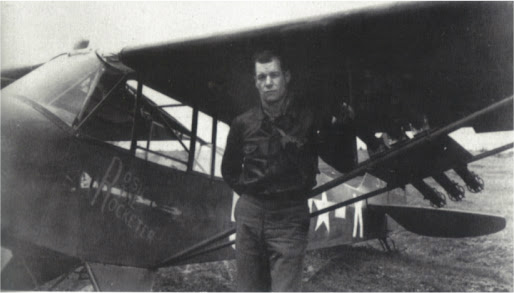… gMad Majorh Carpenter.
"Carpenter joined the Army in 1942 and was commissioned a second lieutenant. After completing flight training and receiving his artillery liaison wings, Carpenter flew light observation aircraft such as the L-4 Grasshopper (Piper Cub) and the Stinson L-5 Sentinel. He accumulated considerable flight time while flying training missions in artillery spotting and enemy reconnaissance and observation.
Promoted to the rank of major in 1944, Carpenter was assigned to combat duty in France with the 1st Bombardment Division.Upon arrival he was assigned an L-4H and assigned to fly artillery support and reconnaissance missions in support of the U.S. 4th Armored Division, part of General George S. Pattonfs U.S. Third Army. The Piper L-4H was a military version of the Piper J-3 Cub, a small fabric-covered, unarmored two-seat aircraft with a fixed-pitch propeller and a 65 hp (48 kW) Continental O-170-3 engine. One of the few distinguishing differences to the Piper L-4 re-design was the addition of additional plexiglass windows above the wing center section, and behind the wingfs trailing edge to increase visibility for the pilot and observer. With a 150-pound pilot and no radio aboard, the L-4H had a combined cargo and passenger weight capacity of approximately 232 pounds according to Wiki
By the time of the Allied siege of Lorient and the encirclement of German forces around that city, Carpenter had grown increasingly frustrated at his inability to attack German armor on those occasions when Allied artillery or tactical aircraft were either out of range or were engaged in other combat missions. Inspired by other L-4 pilots who had installed bazookas as anti-tank armament on their planes, and with the assistance of an Ordnance technician as well as support from the Ninth Air Force Service Command, Carpenter first attached two M1 rocket launchers (bazookas) to the underwing struts of his L-4H, which he named Rosie the Rocketer.After some experimenting, Carpenter would later add two more rocket launchers, then two more for a total of six bazookas, three mounted just above each set of lift struts per side, just outboard of the L-4s jury struts. The M1 bazooka or rocket launcher itself was a solid, one-piece metal tube 54 inches (137 cm) long, and with an unloaded weight of slightly more than 13 pounds (5.9 kilograms) apiece. Carpenterfs original armament of six M1 bazookas each fired a single M6 anti-tank rocket by means of a battery igniter and a toggle-lanyard control operated from the cockpit. The M6 rocketfs HEAT warhead could penetrate approximately three inches (76 mm) of armor at a 30 impact angle. While the M1/M1A1 rocket launcher was initially less than successful when employed by infantry against the frontal armor of German tanks, Carpenter found that using the weapon as an airborne armament scheme (in the manner of plunging fire from any elevated position) was fairly effective at immobilizing a German tank with any solid hit against the thinner armor protecting the top of the turret or the hull superstructure, even against such heavy tanks as the Tiger I. Although the M6 rocket had a theoretical range of 500 yards (457 m), Carpenter preferred to fire his rockets at a range of 100 yards (91 m) or less,adjusting the angle and bore-sighting of the launcher tubes so that when his L-4H was aligned with an enemy vehicle in a shallow dive, the rockets would strike the target.Thus armed, Carpenter began attacking German armored forces…"

Full article here
link
Amicalement
Armand

